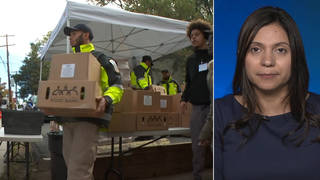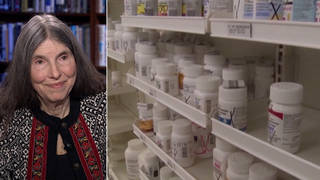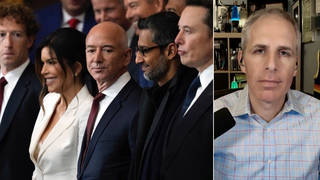
Guests
- Sharifa Rhodes-Pittsauthor of Harlem is Nowhere: A Journey to the Mecca of Black America, part of a trilogy she is working on about African Americans and utopia. Rhodes-Pitts recently launched ”BLACKNUSS: books and other relics,” a new bookstore coming to Harlem.
- Charles Gainesartist and professor at California Institute of the Arts.
After the fourth day of protests over Michael Brown’s death, authorities have declared a state of emergency in St. Louis County, drawing worldwide attention. We look at the state of the Black Lives Matter movement and the art world with two participants in the Creative Time Summit alongside the Venice Biennale in Italy. “At the moment we are dealing with Black Lives Matter and the violence against black and brown people in the United States, Europe is experiencing incredible deaths of black people here too,” says author Sharifa Rhodes-Pitts, noting the “perilous state of people worldwide that have been subjugated to white supremacy and capitalism.” Rhodes-Pitts is the author of “Harlem is Nowhere: A Journey to the Mecca of Black America,” part of a trilogy she is working on about African Americans and utopia. We are also joined by Charles Gaines, a pioneering conceptual artist who teaches at California Institute of the Arts.
Transcript
AMY GOODMAN: We are on the road in Venice, Italy, the site of the Venice Biennale, the oldest and most prestigious international biannual art exhibition in the world. We turn now to look at how the art movement is responding to the Black Lives Matter movement. This comes as authorities have declared a state of emergency in Ferguson, St. Louis County, amidst continuing protests marking the first anniversary of Michael Brown’s death and the shooting Sunday of yet another African-American teenager. Nearly 150 people were arrested Monday as protesters blocked rush-hour traffic on Interstate 70.
To talk about the Black Lives movement and the art world, we’re joined by two artists speaking at the Creative Time Summit here at the Venice Biennale. Sharifa Rhodes-Pitts is with us. She’s the author of Harlem is Nowhere: A Journey to the Mecca of Black America. It’s part of a trilogy she’s working on about African Americans and utopia. Rhodes-Pitts also operates an occasional pop-up bookstore in Harlem called Blacknuss bookstore—Blacknuss bookstore.
SHARIFA RHODES-PITTS: Blacknuss.
AMY GOODMAN: Blacknuss bookstore, that is both—has books and other relics. Also with us is Charles Gaines, a pioneering conceptual artist who teaches at California Institute of the Arts. In 2013, The New York Times said of his work, quote, “If you’re hungry for art that’s beautiful, deeply thought-through and politically unfooled, here it is.”
Charles Gaines, Sharifa Rhodes-Pitts, welcome to Democracy Now! It’s great to have you with us.
SHARIFA RHODES-PITTS: Thank you.
AMY GOODMAN: Now, the two of you has just finished a forum, as we sit here at the Arsenale, which is the heart of the Venice Biennale. You just finished a panel talking about art, talking about politics. Sharifa, you also just wrote a New York Times op-ed piece about Ferguson, about Michael Brown, about slavery. Talk about what you’re thinking about today.
SHARIFA RHODES-PITTS: Sure. Well, the piece actually came out in the fall of 2014 as the case was unfolding. And it is unfortunately always new, as these issues have not gone away and have only in the last year, to a dizzying and astonishing level, increased awareness of the violence, because the thing that we all must remember, and surely not one of your viewers or listeners is innocent of, is that this is not something that’s just happening for the first time now. It’s been happening. And certainly, the work that I wrote and that was published in the Times is kind of about this ongoing history. It starts with a—the observation of a slave evaluation chart from the 1800s, in which the highest-valued enslaved body was that of a 19-year-old black man. And—
AMY GOODMAN: Wait, say that again.
SHARIFA RHODES-PITTS: The highest-valued enslaved body was that of a 19-year-old black man. So this slave chart starts at age zero. The value, the price of a slave rises, it peaks at 19, and from there descends. So the value of a black body descends with age and work and trauma. I just was so astonished the first time I saw that information at the Slave Mart Museum in Charleston, South Carolina.
AMY GOODMAN: And interesting that it was Charleston.
SHARIFA RHODES-PITTS: Indeed. And this was actually several years ago; it was before all of this. I just was thinking about the fact that—what an incredible reversal of fortune, if you can put it that way. And you could make the argument that the least-valued thing in American society is that, is a 19-year-old black man. So I was really interested in tracing the economics of that valuation and sort of tumbling, as we have done, into this history as it lives with us today, which is in these incredible—this incredible violence that has not gone away, and has morphed and renamed itself and uses new tools, but is absolutely unrelentingly connected to our past. And that’s just a great concern of the work that has inspired me and that I’m trying to carry out, is to link this history of the past with the present, and how, if you’re just willing to look at it, it’s there in front of you all the time. So, yeah.
AMY GOODMAN: Now, in headlines, I said 2,800 people came out to a Bernie Sanders event that took place in Portland, Oregon. Actually, it wasn’t 2,800, it was 28,000. But several times now, most recently in Seattle, he was interrupted by members of the Black Lives Matter movement. I was wondering if you could comment on this.
SHARIFA RHODES-PITTS: Sure. I mean, it’s interesting because there’s a sense with—as time is going on and this movement is defining itself and articulating itself and making itself known, the strategy of interruption is continuous, from these political events that are now intersecting with the election season, but also going back to the occasion when members of the Black Lives movement interrupted a rally convened by Al Sharpton’s movement in order to make their voices heard. I mean, this was a very important strategy of saying, you know, “The official bearers of our voices are not on the stage right now. Let us be heard.” That was what happened. And then you can also look to the black brunch protests that were happening in the Bay Area and also in New York, where protesters were going to brunch establishments on Sundays and chanting the names of people that have been killed by police, and just really demanding the space and that this is part of our daily life.
And I think it’s interesting just because there’s a sense of—some people around me are saying, you know, there’s a sense of people waking up, or of this generation waking up and claiming its voice. And so, these strategies, I think, are part of that, of—you know, in some ways, it’s inchoate. It’s not—I think people often look to the past and say, like, “We should model ourselves after this,” or, “The way forward is this.” And as an observer, I see a sense of something that’s happening like in this moment. It’s not referring itself—it’s not building itself directly on past movements, but it’s using the tools of our time in order to do this work, so…
AMY GOODMAN: Speaking of tools of our time, Charles Gaines, longtime artist, talk about the work you’re doing, inspired by what has happened in Ferguson. You are actually trying to write an opera based on Dred Scott and what Dred Scott has to do with Mike Brown and the protests?
CHARLES GAINES: Yes, I was brought into a project by Creative Times to work on a public art installation in St. Louis, and I started this project before Michael Brown was shot. But when I came to St. Louis to visit the site and do research, the Michael Brown incident had happened. So, when I arrived here to do the research, demonstrations had already begun. It was already international news. I had no idea, when I took on this project, that it would become so meaningful. So, while I was doing the research for this, I went to the very famous courthouse in St. Louis where the Dred Scott decisions took place. There were three trials. People don’t really—a lot of people don’t know that. And—
AMY GOODMAN: Dred Scott, who sued for his freedom.
CHARLES GAINES: Yes, and sued for his freedom because he had moved into—
AMY GOODMAN: Together with his wife.
CHARLES GAINES: —an area of—a free state area, brought in by his master, but brought into a free state area, you know, and was trying to say, on the basis of that, he should not be returned to a slave state.
AMY GOODMAN: And the Dred Scott decision?
CHARLES GAINES: And the decision, it was—it went against him at first, but then, ultimately, on a retrial, he and Harriet gained their freedom. Now, while I was doing this—I mean, I have a little joke about that, because I was looking through the Dred Scott files, and the entire file—this is one of the most important legal judgments in the history of American law, because it really had to do with determining, in legal language, who is human and who is half-human, and who is free and who is not free. And that file for the cases may be like three inches thick. And I would say that my first divorce papers’ files are bigger than that. So, and this was one of the most important. So while I was going through those papers and reading the various judgments and so forth, I could hear outside the courthouse the demonstrations taking place, and it had a profound effect on me, because I realized at that point that the Dred Scott trial isn’t over.
AMY GOODMAN: And finally, the art exhibit you wanted to do at the base of the St. Louis Arch—and we just have a minute, so if you could describe it very succinctly?
CHARLES GAINES: Oh, yes, this is a structure that’s 200 feet long and about 10 feet wide, that the top of it is made up of chains, very thick mooring chains, that rotate to simulate the Mississippi River. And you can go inside the structure and stand underneath these chains and watch the chains move above you.
AMY GOODMAN: Like a river of chains.
CHARLES GAINES: Yes, but also, that then metaphorized a slave ship.
AMY GOODMAN: And finally, the Arch, what it means to you?
CHARLES GAINES: Yeah, I mean, this is the thing, that the Arch was—
AMY GOODMAN: Famous St. Louis Arch.
CHARLES GAINES: Yeah, the Saarinen Arch was a symbol for American progress, American pioneering spirit, because St. Louis was on the border of the American frontier at the time of the Lewis and Clark expeditions and so forth. And the Arch is to celebrate that and also to celebrate the importance of St. Louis in American history. I recognized that there was another side of the story, that one where you can read, that is the celebration of manifest destiny as a celebration of imperial and colonial empowerment. And I wanted to bring that narrative out in my project.
AMY GOODMAN: Finally, Sharifa Rhodes-Pitts, what being here in Venice, as all that’s taking place in the United States that you’re both deeply involved with, means?
SHARIFA RHODES-PITTS: Well, one thing that comes to mind immediately is connections. You know, at the moment that we’re dealing with Black Lives Matter and the violence against black people and brown people in the United States, Europe is a experiencing incredible deaths of black people here, too. Actually, after Venice, I’m planning to go down to Lampedusa, which is the kind of the center of migration, where people from the Near East and Africa come through Lampedusa in order to arrive in Europe. So, this perilous state of people worldwide that have been subjugated to white supremacy and capitalism is the thing that I think of. And here is—it’s just one occasion, among many, to consider those connections.
AMY GOODMAN: Well, I wish we could continue this discussion, and we will. Sharifa Rhodes-Pitts and Charles Gaines, the conversation continues. Sharifa Rhodes-Pitts’ book is called Harlem is Nowhere: A Journey to the Mecca of Black America.
That does it for our broadcast. We have a social media editor full-time job opening in New York. Check our website at democracynow.org. Special thanks to our crew here: Denis Moynihan, Mike Burke, John Hamilton, Amy Littlefield. I’m Amy Goodman. Thanks so much for joining us from Venice, Italy.












Media Options